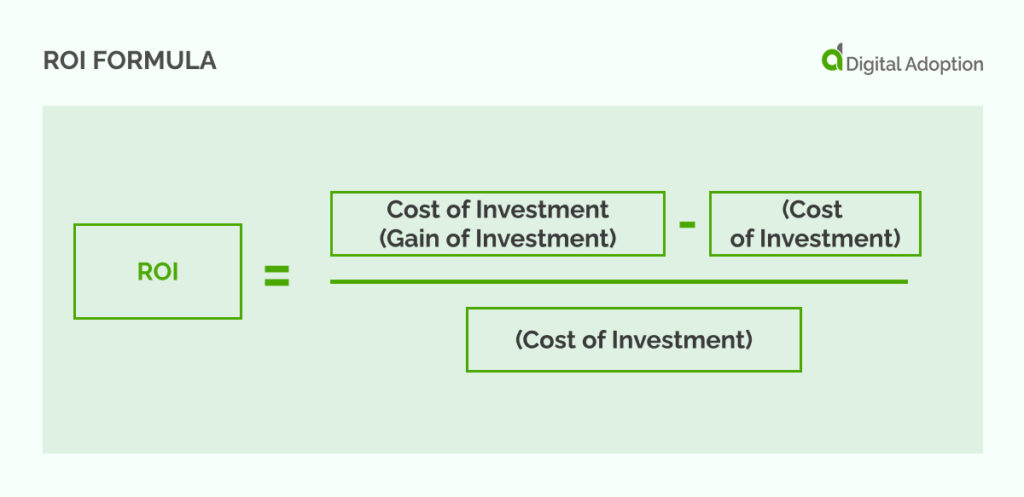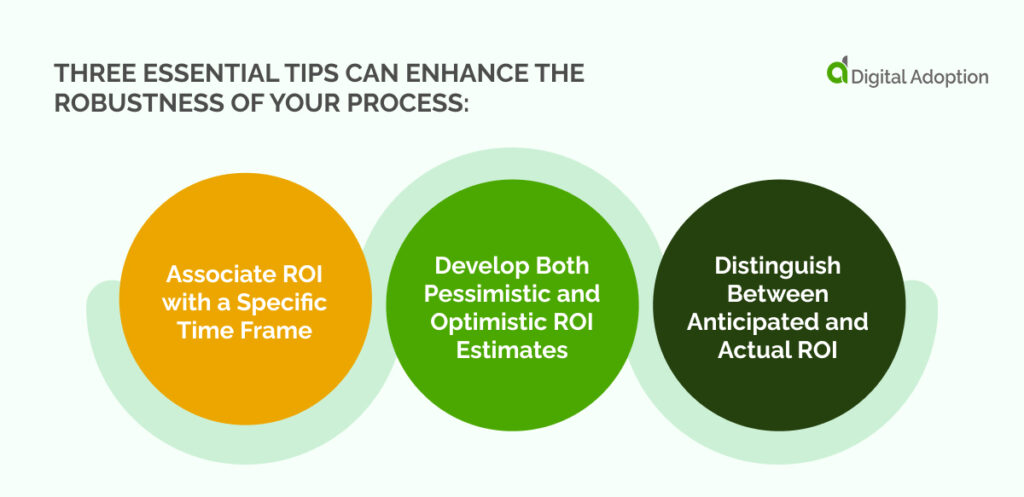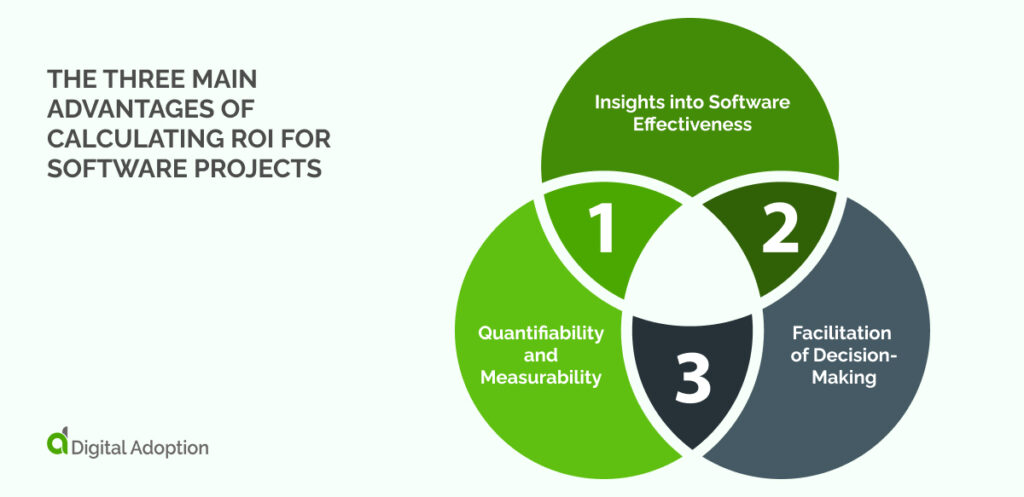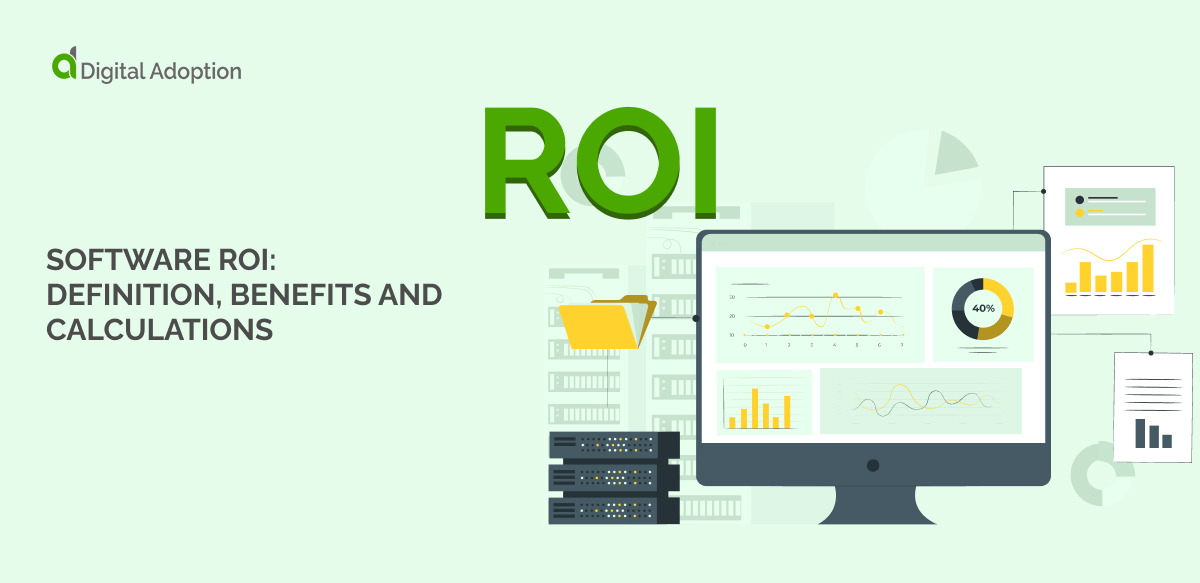Software ROI, or software return on investment, is a crucial metric to assess the financial returns an organization expects from investing in enterprise technology.
Based on specific formulas and metrics, this evaluation guides product leaders in making informed decisions about selecting and allocating resources for costly software solutions.
Measuring software ROI can be more challenging than measuring other investments because of intangible benefits, like enhanced customer satisfaction or elevated brand awareness.
Thus, businesses must adopt a holistic approach to calculating software ROI, considering both direct and indirect financial benefits. This comprehensive evaluation helps understand the full impact of software investments on the organization’s overall performance.
After reading this guide, you will understand:
- What ROI is and the formula for calculating it
- The advantages of software ROI
- How to calculate software ROI depending on the type of project
- The best practices associated with software ROI
What Is ROI?
Return on investment (ROI) is a concrete financial metric that compares the cost of an investment to its benefit.

The formula for calculating ROI is universal, applying to software investments and other types as well:
ROI = Cost of Investment (Gain of Investment)−(Cost of Investment)/(Cost of Investment)
The essential factors of this calculation are:
Gain of Investment
This is the financial gain from the new software. For example, software that ensures regulatory compliance can reduce the risk of fines. Efficiency improvements, such as time saved or increased work capacity, also contribute to the gain.
Additionally, replacing an old system with a new one might save costs previously incurred, which can be considered a gain.
Cost of Investment
This includes all expenses for implementing and maintaining the new software, such as licensing fees, tech support, and subscription services.
It also encompasses indirect costs like installation, an employee training program, opportunity costs of time spent learning the system, and productivity loss during the transition. Factor in functionality losses compared to the previous system as part of the investment cost.

When calculating software return on investment (ROI), three essential tips can enhance the robustness of your process:
Associate ROI with a Specific Time Frame
ROI changes over time and is typically lower in the early stages due to initial investments, like setup costs, training expenses, and other upfront expenditures.
Over time, the ROI generally increases as productivity improves, or revenue begins to flow. Calculating ROI for a defined period is crucial to reflect these changes accurately.
Develop Both Pessimistic and Optimistic ROI Estimates
Calculate two types of ROI forecasts to capture a realistic range of outcomes. A pessimistic estimate assumes minimal gains and maximal costs, while an optimistic estimate considers the highest likely gains with the lowest possible costs.
This dual-estimate approach provides a spectrum of potential results, making it easier to present and justify to stakeholders.
Distinguish Between Anticipated and Actual ROI
ROI can be divided into two categories: Anticipated ROI and Actual ROI. Anticipated ROI is calculated during the planning phase, using estimated costs, expected revenues, and other assumptions to predict the project’s profitability.
Actual ROI, on the other hand, is determined after the software has been in use for some time. It uses the final costs and actual revenues to assess the project’s profitability in reality, comparing it against the initial estimates.
This distinction helps in understanding the accuracy of projections and the real impact of the software investment.
What Are The Advantages Of Calculating ROI For Software Projects?
Calculating software ROI is a vital process for organizations as it offers several benefits:
Quantifiability and Measurability
Software ROI offers a tangible and measurable method to evaluate a software investment’s financial return. This metric lets organizations track their investment performance and make data-driven decisions about future technology investments.
For example, suppose a company spends $10,000 on project management software and subsequently saves $15,000 in labor costs within a year. In that case, the software’s ROI is calculated at 100%, providing a precise measure of its financial benefit.

Insights into Software Effectiveness
Beyond financial returns, software ROI also sheds light on the software’s overall effectiveness. Organizations can assess whether the software effectively addresses their needs and contributes to their broader objectives by analyzing the net benefits versus the costs.
For instance, if a company invests $30,000 in workflow automation software and generates an additional $60,000 in revenue, the 150% ROI indicates the software’s high effectiveness in revenue generation.
Facilitation of Decision-Making
The primary goal of calculating software ROI is to guide informed decisions regarding software investments. Organizations can determine if an investment is justified by offering a straightforward way to understand the financial benefits of software.
For example, suppose a company contemplates investing $40,000 in new customer service software and projects a $80,000 net benefit in the first year. This ROI calculation is instrumental in deciding whether to proceed with the investment based on its expected financial returns.
In summary, software ROI calculations are vital in quantifying investment returns, assessing software effectiveness, and guiding strategic decision-making about digital technology investments within an organization.
How To Calculate Software ROI Depending On The Project
The methods to measure ROI vary based on the type of software being developed, and understanding this is crucial for accurately assessing the return on software projects.
Business Process Software
This type of software is designed to enhance internal business processes and workflows.
To measure its ROI, consider the following factors:
- Operational Costs: Look at the cost of operating the software.
- Revenue Growth: Evaluate the potential for increased revenue through more efficient operations, which could secure more deals or attract more clients with the same workforce.
- Sales Efficiency: Assess the impact on sales efficiency, including growth and development opportunities.
- Risk Management: Evaluate how the software helps anticipate and avoid problems or manage crises, thereby reducing risks.
- Lead Generation and Customer Retention: Determine the rate of acquiring new leads and retaining existing customers by improving customer experience.
- Time, Energy, and Resource Savings: Calculate savings achieved through data integration and streamlined business processes.
Commercial Software or SaaS (Software as a Service)
SaaS companies create software to service clients and generate revenue. ROI for SaaS can be measured in terms of monthly or annual recurring revenue (MRR/ARR).
Additionally, clients assess the ROI of the software based on factors like:
- Time Savings: Evaluate the saved hours across different teams and roles.
- Lead Generation and Deal Closure: Assess the increased opportunities for generating leads and closing deals.
- Customer Service Improvement: Measure customer retention cost, growth, or acquisition impact.
- Risk Management and Problem Solving: Evaluate how the software anticipates and solves problems.
For software projects in general, consider these measurable factors:
- Sales: An increase in sales post-implementation indicates a positive ROI.
- Efficiency: Enhanced employee efficiency following the deployment signifies a beneficial impact.
- Production: Automation of repetitive tasks leading to a focus on main activities like sales and marketing, enhancing productivity.
- Processes: Compare the cost-efficiency of processes before and after software implementation.
- Savings: Examine both direct and indirect cost savings brought about by the new software.
Each type of software requires a tailored approach to measuring ROI, focusing on different aspects of operational improvement, financial gains, and efficiency enhancements.
Best Practice For Software ROI Implementation
Investing in software requires careful planning to maximize revenue and achieve business goals. Here are four effective strategies:
Set Goals and Metrics Early
Define clear objectives and metrics for the software’s impact on your business. For instance, if a company invests in inventory management software, it might aim to reduce inventory costs by 15% and increase turnover by 30%.
Setting these goals early provides a roadmap for expected software benefits and allows tracking progress against these metrics.
Conduct Comprehensive Software Evaluation
Before investing, evaluate the software thoroughly to ensure it fits your business needs. Consider features, functionality, scalability, cost, and vendor support.
For example, a company choosing customer service software would compare features and costs to find the best fit. Questions to consider include the team’s adaptation time, necessary features, future needs, and customization options as your organization grows.
Ensure Adequate Training and Support
Maximize software effectiveness by providing comprehensive training and support. For example, a company using new accounting software could train all relevant employees through software walkthroughs and give access to technical support, ensuring efficient use and quick issue resolution.
Regularly Monitor and Evaluate ROI
Continuously assess the software’s business impact using key performance indicators (KPIs) aligned with your goals. Common KPIs include return on investment, user adoption rates, efficiency improvements, and customer satisfaction.
For instance, with a new CRM software, track customer retention and feedback to gauge impact. Regular KPI monitoring helps make informed decisions and adjustments for optimal software utilization.
Final Thoughts On Software ROI
Software ROI, short for Return on Investment, is a crucial metric for gauging the financial benefits of investing in software. It helps organizations assess the profitability of their software investments and aids in making well-informed decisions about future investments in technology.
A positive ROI suggests that the software has generated more revenue or cost savings than its initial cost, indicating a successful investment. Conversely, a negative ROI shows that the software has not produced sufficient financial returns, signifying a less favorable investment. An ROI of 0 means the software hasn’t added any additional financial value beyond its cost.
Understanding and effectively communicating software ROI is vital for organizations. It enables them to make data-based decisions, streamline operations, and maintain a competitive edge.
Regularly monitoring key performance indicators and adapting software usage as necessary ensures that software investments positively impact the bottom line and provide lasting value.
Additionally, presenting a clear and compelling ROI calculation in your pitch decks or presentations is essential. It demonstrates the long-term value of the investment to internal stakeholders and investors and makes it easier to convince those who may be uncertain about the investment’s worthiness.
This approach underscores the importance of solidly grasping ROI calculations to support strategic decisions in software investment.













